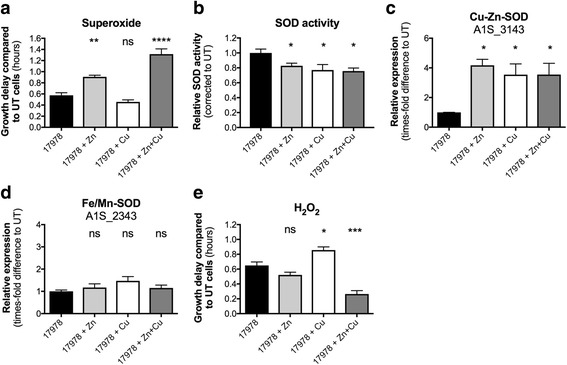Fig. 5.

The effect of Zn and Cu treatment on the resistance of A. baumannii to oxidative stress. The effect of (a) 40 μM paraquat and (e) 160 μM H2O2 on A. baumannii strain ATCC 17978 grown in the presence of 400 μM Zn, 400 μM Cu, 400 μM Zn + 400 μM Cu, or without added metal ions, was determined by measuring the optical density at 600 nm (OD600). The growth delay between untreated (UT) and paraquat- or H2O2-treated cells was examined by comparing the EC50 under each relevant metal ion stress condition. Statistical analyses were performed using a one-way ANOVA. b The total SOD activity of mid-log phase cells (untreated, 400 μM Zn, 400 μM Cu or 400 μM Zn + 400 μM Cu) was determined. Data were corrected for total protein content, followed by normalisation to untreated cells. Statistical analyses were performed using a Student’s t-test. The mRNA transcription levels of (c) Cu-Zn superoxide dismutase (Cu-Zn-SOD; A1S_3143), (d) Fe/Mn superoxide dismutase (Fe/Mn-SOD; A1S_2343) were determined by qRT-PCR. The transcription levels examined in the presence of 400 μM Zn, 400 μM Cu or 400 μM Zn + 400 μM Cu were corrected to untreated cells following internal normalisation to GAPDH. The data are the mean of at least biological triplicates (± SEM). Statistical analyses were performed by one-way ANOVA using Dunnett’s posttest. For all statistical analyses; ns = not significant, * = p < 0.05, ** = p < 0.01, *** = p < 0.001 and **** = p < 0.0001
